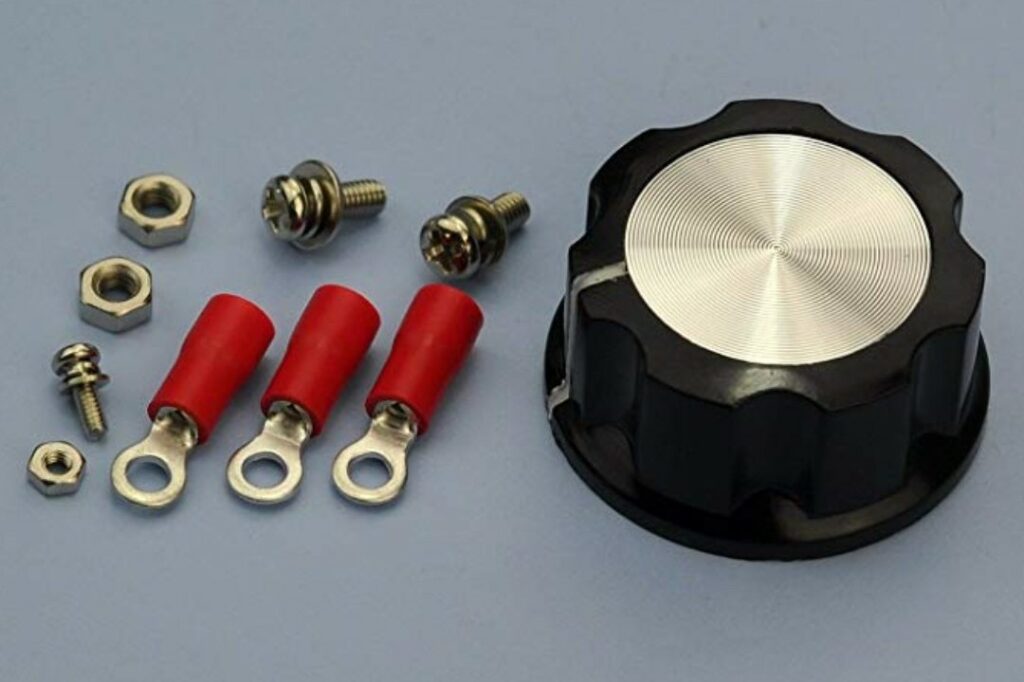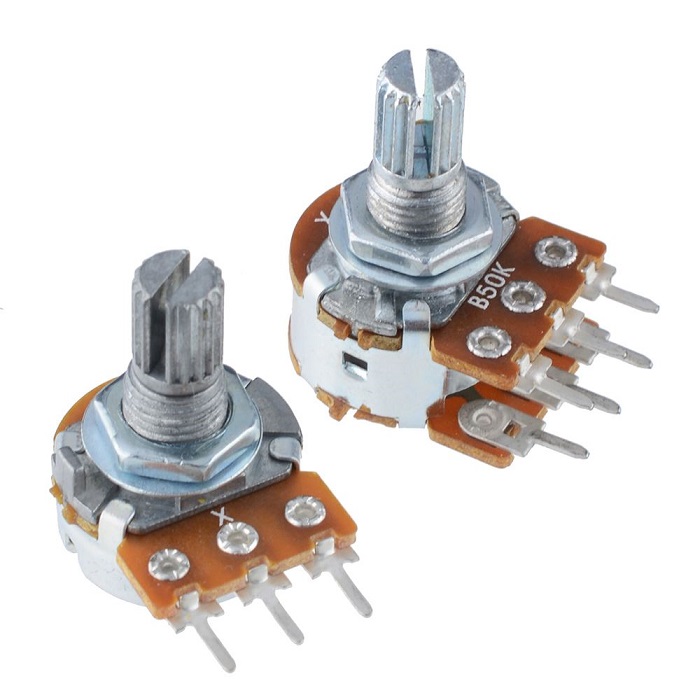The resistor is one of the most common types of elements in electrical devices today. They are two-terminal components that will create a resistance to the flow of current. Resistors help to make the management of the current much simpler, and they are a common part of most electronics in today’s world. In this article, Linquip will discuss what a variable resistor is and how it works. Read on to find out more.
What is a variable resistor?
It is an electronic component. It is applied in an electronic circuit for adjusting circuit resistance to control voltage or current of that circuit or part of that circuit. The electrical resistance is varied by sliding a wiper contact along a resistance track. Sometimes the resistance is adjusted at preset value as required at the time of circuit building by adjusting screw attached to it and sometimes resistance can be adjusted as when required by controlling knob connected to it. The active resistance value of the variable resistor depends upon the position of the slider contact on the resistance track.
It mainly consists of a resistance track and a wiper contact. The wiper contact moves along the resistance track when the adjustable component is adjusted. There are mainly three different types of resistance track used in this resistor they are carbon track, cermet (ceramic and metal mixture) track, and wire-wound track. The carbon track and cermet track are used for high resistance application whereas the wire-wound track is used for low resistance variable resistor. The resistance tracks generally are circular but a straight track is also used in many cases.
Variable Resistor Types
The different types of variable resistors include:
-
Potentiometer
The potentiometer is the most common variable resistor. This potential divider is used to generate a voltage signal depending on the position of the potentiometer.
The potentiometer consists of three terminals among which two are fixed and one is changeable. The two fixed terminals of the potentiometer are connected to both ends of the resistive element called track and the third terminal is connected to the slider or sliding wiper. The slider or wiper moving along the resistive track changes the resistance of the potentiometer. The resistance of the potentiometer is changed when the wiper is moved over the resistive path.
The potentiometer can be used for a wide variety of applications including Amplifier gain control (audio volume), measurement of distance or angles, tuning of circuits, and much more. When variable resistors are used to tune or calibrate a circuit or application, trimmer potentiometers or trim pots are used, this is mostly small potentiometers mounted on the circuit board, which can be adjusted using a screwdriver.
-
Rheostat
The word rheostat is derived from the Greek word “rheos” and “-statis” which means a current controlling device or a stream controlling device. Rheostats are very similar in construction to potentiometers but are not used as a potential divider but as a variable resistance. They use only 2 terminals instead of the 3 terminals potentiometers use: one connected to an end of the track, the other to the moveable wiper. Turning the spindle changes the resistance between the two terminals from zero up to the maximum resistance.
In the past rheostats were used as power control devices in series with the load, such as a light bulb. Nowadays rheostats are not used as power control anymore as this is an inefficient method. For power control, rheostats are replaced by more efficient switching electronics. Preset variable resistors, wired as rheostats, are used in circuits to perform tuning or calibration, for example, to control the brightness of a lamp or the rate of charging a capacitor.
If a rheostat is mounted on a printed circuit board all three terminals are usually soldered for better mechanical strength. The third terminal serves no electrical function but is usually linked to the wiper terminal.
-
Digital Resistor
A digital variable resistor is a type of variable resistor where the change of resistance is not performed by mechanical movement but by electronic signals. They can change resistance in discrete steps and are often controlled by digital protocols such as I2C or by simple up/down signals.
-
Thermistor
The word thermistor is derived from the combination of words: thermal and resistor. It is a type of resistor whose resistance changes when the surrounding temperature changes.
Thermistors are of two types: negative temperature coefficient (NTC) thermistors and positive temperature coefficient (PTC) thermistors.
The resistance of the NTC thermistors decreases when the temperature increases whereas the resistance of the PTC thermistors increases when the temperature increases.
-
Magneto resistor
The resistance of the magneto resistor changes when the magnetic field is applied to it. When the strength of the magnetic field applied to the magneto resistor increases, the resistance of the magneto resistor also increases. Similarly, when the strength of the magnetic field applied to the magneto resistor decreases, the resistance of the magneto resistor also decreases.
-
Photoresistor
The word photoresistor comes from the combination of two words: photon and resistor. The resistance of photoresistor changes when light energy is applied to it. The resistance of the photoresistor decreases when the intensity of applied light increases. There are two types of photoresistors based on the material used in constructing them. They are either intrinsic photoresistors or extrinsic photoresistors.
Photoresistors are also known as light-dependent resistors, semiconductor photoresistors, or photoconductors.
-
Humistor
The name humistor is derived from the combination of two words: humidity and resistor. Humistors are very sensitive to the humidity. The resistance of the humistor changes with a slight change in the humidity of the surrounding air. Humistors are also known as resistive humidity sensors or humidity sensitive resistors.
-
Force-sensitive resistors
The name itself suggests that the force-sensitive resistors are very sensitive to the applied force. When we apply force to the force-sensitive resistor, its resistance changes rapidly. Force-sensitive resistors are also known as force sensors, pressure sensors, force-sensing resistors, or FSR.
-
Presets
Presets are miniature versions of standard variable resistors. They are mounted directly onto circuit boards and adjusted only when the circuit is built. For example, they may be used to set the frequency of an alarm tone or the sensitivity of a light-sensitive circuit. A small screwdriver or similar tool is usually required to adjust presets.
Presets are available in vertical and horizontal styles. They are electrically identical but make sure you buy the correct type for your circuit board layout. Horizontal presets provide better mechanical strength on a circuit board.
Presets may be open (no case) or enclosed within a plastic case to protect them from dust and dirt. Because they are cheaper than standard variable resistors, they are often used in educational and hobby projects.
Multiturn presets are used where very precise adjustments are needed. The screw must be turned many times (10+) to move the slider from one end of the track to the other, giving fine control.
Variable Resistor Diagram
As mentioned above, the way a variable resistor works is simple. A sliding contact on a long coil of wire or length of graphite changes the amount of material in the circuit. The longer the length in the circuit, the higher the resistance and the smaller the current. So using it to turn the brightness of a bulb up and down the circuit diagram would be:
Variable Resistor Symbol
The following table shows the most common resistor symbols for electronic design.
| Variable resistors | Symbols |
| Potentiometer |  |
| Rheostat |  |
| Preset |  |
| Thermistor |  |
| Magneto resistor |  |
| Photoresistor |  |
Variable Resistor Function
Simply put, a variable resistor can have its electrical resistance adjusted. These devices are used when working with electrical circuitry because they help to control voltage and currents. They specifically work with voltage and currents that are a part of the circuit. The adjustability of these devices is simple. Each resistor comes with a wiper contact that can be slid up and down the resistance track. The resistor can be adjusted at present values, which is a requirement of building the circuit. Later, a controlling knob that is connected can make adjustments. The wiper contact and where it sits on the resistance track is what determines the resistance value of the variable resistor.
variable resistor Circuit
Variable resistors are used to dynamically change the resistance to control the current in a circuit, and may also be used as a voltage divider. For example, they are used to control the volume on a radio. Potentiometers differ from regular resistors in that they have three terminals instead of two. The middle terminal is the “wiper.” When a potentiometer is used as a voltage divider, all three terminals are wired separately. But when the potentiometer is wired as a rheostat, only two connections are needed.
Either side of the variable resistor may be attached to the circuit board, with the remaining side unattached or grounded, but it is important to always connect the wiper. The wiper must be grounded or affixed to the voltage source. For example, you can attach the left terminal of the pot to the voltage source and the wiper to the ground, or use the right terminal instead of the left. Changing the side affects the direction of rotation for the potentiometer’s maximum resistance.
So, there you have a detailed description of a variable resistor and its applications. If you enjoyed this article in Linquip, let us know by leaving a reply in the comment section. Is there any question we can help you with? Feel free to sign up on our website to get the most professional advice from our experts.
Buy Equipment or Ask for a Service
By using Linquip RFQ Service, you can expect to receive quotations from various suppliers across multiple industries and regions.
Click Here to Request a Quotation From Suppliers and Service Providers
Read More In Linquip
- What is Shunt Resistor? + Function & Applications
- What Are Resistors for LED Circuits? (Clear Guide)
- A Quick Guide to Resistor Color Code
- Types of Resistor: classification, application, and finally clarification
- Mastering Resistance Calculations: A Comprehensive Guide for Electrical Enthusiasts
- What are the Different Types of Actuators?
- variable resistor symbol։ everything you need to know
- Everything You Need to Know About Variable Resistor Function
- A Quick Guide to Resistor Sizes and Packages
- What is Pull-up and Pull-down Resistors? + Typical Application
- All You Need to Know About Guide to Resistor Values
- What is Braking Resistor? (A Practical Guide)






Hi. I’m presently fixing an old (30 years) amplifier which in part of an old USA build record deck, designed for Barn Dance Callers. The volume control potentiometer has previously been replaced and I’m not sure if it’s the correct value. It 25k ohm. I don’t have a circuit diagram so I’m feeling my way along. I noticed that the volume starts immediately the pot is turned up. Over time, the pot has worn out at this point (with bad crackles etc) and is not suitable for gigs anymore. I was wondering if a logarithmic pot would work better … by giving more of a turn before the volume starts. Or do I stay with a linear pot? Any advice would be appreciated . Thanks
Thanks Harry for visiting our website and also sharing your experience with us! You can communicate with one of our experts, who can completely help you solve your issue.